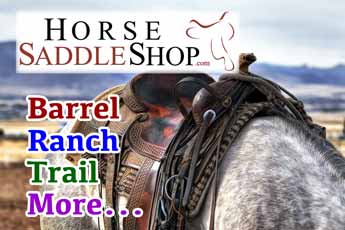Cowboy Dictionary - Letter H-I
Hack Rein - A hack rein is a type of rein used by bronc riders. For more information, please see What Is A Hack Rein?
Hackamore: A piece of equipment put on a horse's head to communicate with it while it is being ridden. A hackamore consists of a bosal, a hanger, and a mecate.
- The bosal. The bosal goes around the nose of the horse and has a knot at the back, underneath the horse's chin.
- The hanger (sometimes called a headstall, this is the part that goes over the horse's head, behind the ears).
- The mecate, or reins. Traditional mecates are made from horsehair but some may be made from nylon or other synthetic materials. The nicer horsehair mecates are made from mane hair, but some are made from tail hair, which is coarser.
Below: A hackamore.
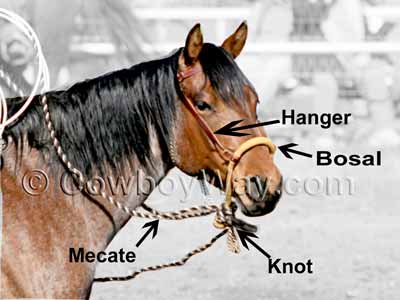
Half - When referring to acreage, a "half" is a half section of land. A full section of land is 640 acres, so a half section is 320 acres.
Advertisement - Article continues below.
Half Head: In team roping and some other competitive roping events, a half head is one of three legal head catches.
The other two legal head catches are a whole head (sometimes called "around the neck"), and around both horns (sometimes called a "horn catch" or "a clean horn catch").
A half head catch is pictured below. The loop goes on top of one horn, underneath the chin, and underneath the other horn.
We have more information about the three legal head catches.
Below: A half head catch, one of three legal head catches in team roping and some other competitive roping events.
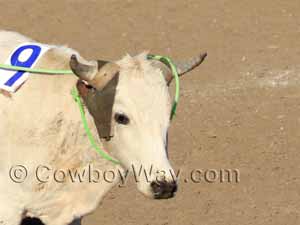
Halter - A head collar for leading, tying, and general handling of horses and cattle.
In horses, a halter is commonly used so the handler can catch, lead, tie, hold, transport, or handle the horse in general. A "lead rope" is a rope that attaches to a halter, whether temporarily or permanently, and gives the handler a lead to hold on to and use for directing the horse.
A horse that willingly accepts a halter and allows itself to be led by the handler is called "halter broke."
In cattle, a halter is commonly used for the same reasons as in horses. However, it is far less common to halter break cattle than horses. Cattle that are commonly halter broke are those that compete in the show ring.
Below: A horse wearing a style of halter called a "rope halter." The lead rope can be seen coming down from the bottom of the halter.
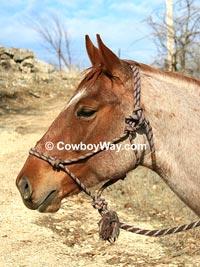
Hand - A unit of measurement for measuring horse height. One hand is equal to four inches.
To measure horse height a horse is measured from the ground to the highest point of its withers. This measurement, taken in inches, is converted to hands to describe a horse's height.
We have a more detailed article on "hands" and how to measure horse height here.
Below: The height of a horse is measured from the ground to the highest point of its withers.
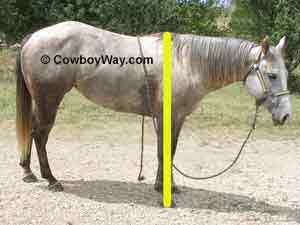
Headstall - A headstall is a hanger put on a horse's head used for holding a bit, bosal, nose piece, or other piece of equipment to control a horse while riding.
When a headstall is combined with a bit (or bosal, nose piece, etc.) the combination is known as a bridle. For more information about headstalls, please see our article "The Main Parts of a Headstall" (the article is beneath the headstalls for sale).
Heifer - A young female belonging to the genus Bos, which includes the species cattle. When a heifer matures, she is called a cow.
One example of using the word heifer: "One of the cows had a heifer calf last night." This lets it be known that the cow gave birth to a female calf, as opposed to a bull (male) calf.
The term heifer is often used to describe young females up to 1-2 years of age. After that she is usually expected to give birth to her first calf, and then is referred to as a cow.
One exception to this is a "first calf heifer." A first calf heifer is a young female that is pregnant with, or given birth to, her first calf. She is described as a first calf heifer, instead of a cow, in order to let it be known she is still a young animal.
Honda - A honda is the small loop at the end of a lasso or lariat type of rope.
When the opposite end of the rope is passed through the honda, a larger loop is created. This larger loop is used by cowboys and cowgirls to rope cattle.
A honda can be made by forming a small loop in the end of the rope, then tying the loop in place with a special knot (a honda knot).
A honda might also be a separate piece that is added to the rope. This type of honda might be made of metal, braided rawhide, or other materials.
You can learn how to tie a honda knot here.
Below: The blue arrow is pointing to a honda.
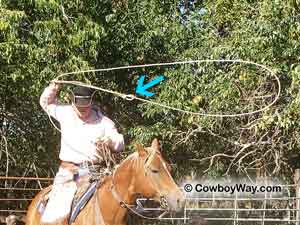
Horn Knot - A "horn knot" is a small piece of equipment used for attaching a rope to a saddle horn. A horn knot is used when the roper wants to "tie hard" instead of dallying.
A horn knot can be made of a variety of different materials such as metal, braided nylon or rawhide, plastic, and others.
For more information about horn knots, including how to put one on your rope, please see this page: How To Put A Horn Knot On A Rope.
Below: A metal horn knot.
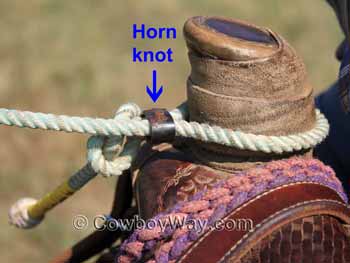
Horns - Horns are growths that protrude from the skulls of some animals in the family Bovidae. Horns are made of bone and keratin. Animals that have horns include cattle, sheep, goats, gazelles, antelope, bison, and buffalo.
As stated above, horns are made of bone and keratin. The bone is the center, or core, of the horn and is fused to the bone of the skull. The bone core is covered by a resilient sheath (protective covering) made of keratin.
Horns are a permanent part of the animal, which means the horns an animal is born with are the same horns it has its entire life. In other words, horns are not shed and re-grown like antlers.
Below: A Longhorn cow skull. On the right-hand side of the photo the keratin sheath that protects the bone core of the horn has slipped off and is lying on the ground beside the skull.
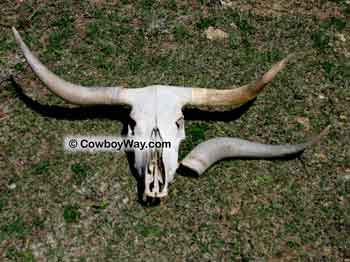
Some people are under the mistaken impression that only male animals can have horns, but in cattle as well as some other species both males and females can have them.
For more information about horns, please see our article about cow horns.
To purchase cow skulls, please see this page: Cow Skulls For Sale.
Horse - A hoofed mammal best known for being used by humans as a riding animal, beast of burden, and companion.
The domesticated horse is classified by science as being:
- A member of the genus Equus and the species Caballus
- A mammal (meaning among other things that they are warm-blooded vertebrates, have hair, and nurse their young)
- A quadruped (they have four limbs used for walking)
- An herbivore (their diet consists mainly of vegetation)
- And an ungulate (having hooves)
Below: A horse
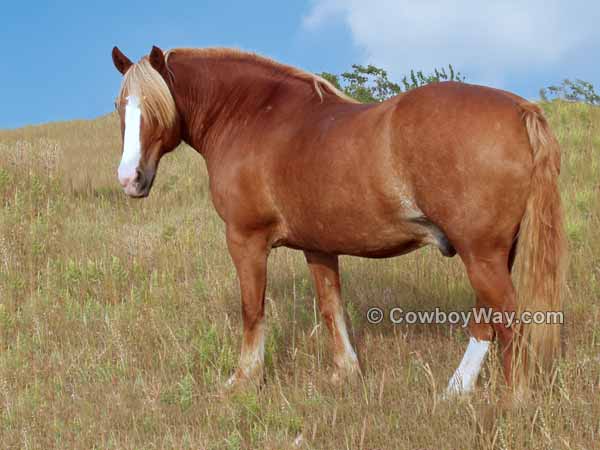
Common horse terms include:
- Colt - A young male horse, 4 years old or younger
- Filly - A young female horse, 4 years old or younger
- Foal - A newborn or very young horse, male or female
- Gelding - A male horse that has been castrated, or gelded
- Mare - A mature female horse
- Stallion - A male horse that has not been castrated
- Dam - The term give to a female horse when she becomes a mother
- Sire - The term given to a stallion when he becomes a father
We have a page full of interesting horse facts and trivia.
Horse Colt - "Horse colt" is another way of saying "colt," which is a young male horse, 4 years old or younger.
In casual conversation some people refer to any young horse, male or female, as a "colt." Therefore, the term "horse colt" is sometimes used to make sure there is no misunderstanding that the young horse is a male.
Hot Brand - A brand is permanent mark on the hide of an animal, and is used for identification of ownership. A hot brand is made by using a hot branding iron (as apposed to a freeze brand which uses a very cold branding iron).
Below: A brand on a horse.
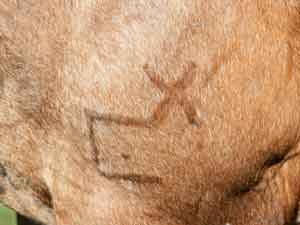
Hypsodont Teeth - Hypsodont teeth are teeth with high crowns that slowly continue to emerge from the gum for most of the animal's life. As the top of the tooth is worn down, more tooth slowly erupts from the gum line to replace what has been worn away.
Horses and other grazing animals like cattle and deer have hypsodont teeth.
Below: A horse skull with teeth.
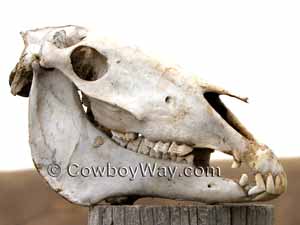
Interdental Space - An area in a horse's mouth, both on the upper and lower jaws, where there is not any teeth.
The interdental space is between the front teeth (the incisors) and the back teeth (the molars). When a horse is bridled, the interdental space is where the bit rests. On the bottom jaw, most horsemen refer to this area of bare gums as the "bars."
Below: The yellow arrows are pointing to the interdental space.
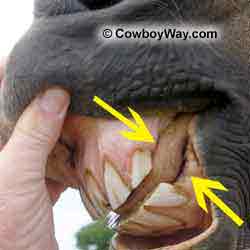
Definitions
… Letter C
… Letter S
… Letter T
You Might Also Like
